CNH Industrial Bundle
How Did CNH Industrial Rise to Global Prominence?
Ever wondered about the journey of a global leader in the capital goods sector? CNH Industrial, a name synonymous with agricultural and construction equipment, boasts a rich and dynamic history. From its roots in pioneering industrial enterprises to its current status, CNH Industrial's story is one of strategic mergers and relentless innovation. This CNH Industrial SWOT Analysis can give you more insights into the company.
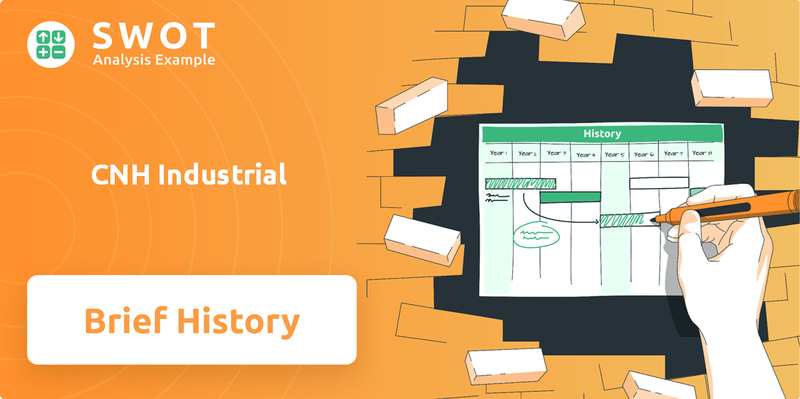
Delving into the brief history of CNH Industrial reveals a company built on a foundation of groundbreaking advancements in agricultural equipment and other industrial sectors. The CNH company's evolution reflects a commitment to meeting the evolving needs of its customers worldwide. Understanding the CNH history is crucial for anyone interested in the agricultural equipment and construction equipment industries, as well as the broader capital goods market.
What is the CNH Industrial Founding Story?
The story of CNH Industrial begins with a strategic merger that took effect on November 12, 2012. This union brought together the strengths of Fiat Industrial S.p.A. and CNH Global N.V., creating a global leader in the agricultural and construction equipment sectors. This merger was a pivotal moment in the CNH Industrial company timeline, shaping its current structure and market position.
Fiat Industrial, a spin-off from Fiat S.p.A. in 2011, contributed its agricultural and construction equipment (CNH Global), trucks and commercial vehicles (Iveco), and industrial powertrains (FPT Industrial) businesses. Simultaneously, CNH Global N.V., formed in 1999 through the merger of New Holland N.V. and Case Corporation, brought decades of experience in agricultural and construction machinery to the table. This combination of expertise and resources set the stage for CNH Industrial's future success.
The initial problem identified by the precursors to CNH Industrial was the need for more efficient machinery to support agricultural and construction efforts worldwide. Case Corporation, founded in 1842 by Jerome Increase Case, initially focused on building threshing machines to address the labor-intensive nature of grain harvesting. Similarly, New Holland's origins in 1895 with Abe Zimmerman in Pennsylvania were centered around practical solutions for farmers. These early businesses aimed to mechanize arduous tasks, boosting productivity and improving livelihoods, which remains a core focus of the company today.
The formation of CNH Industrial was a strategic move to combine strengths and expand market reach.
- Fiat Industrial's spin-off from Fiat S.p.A. in 2011.
- CNH Global N.V. formed in 1999 through the merger of New Holland N.V. and Case Corporation.
- Case Corporation, founded in 1842, initially focused on threshing machines.
- New Holland's origins in 1895 provided practical solutions for farmers.
CNH Industrial SWOT Analysis
- Complete SWOT Breakdown
- Fully Customizable
- Editable in Excel & Word
- Professional Formatting
- Investor-Ready Format
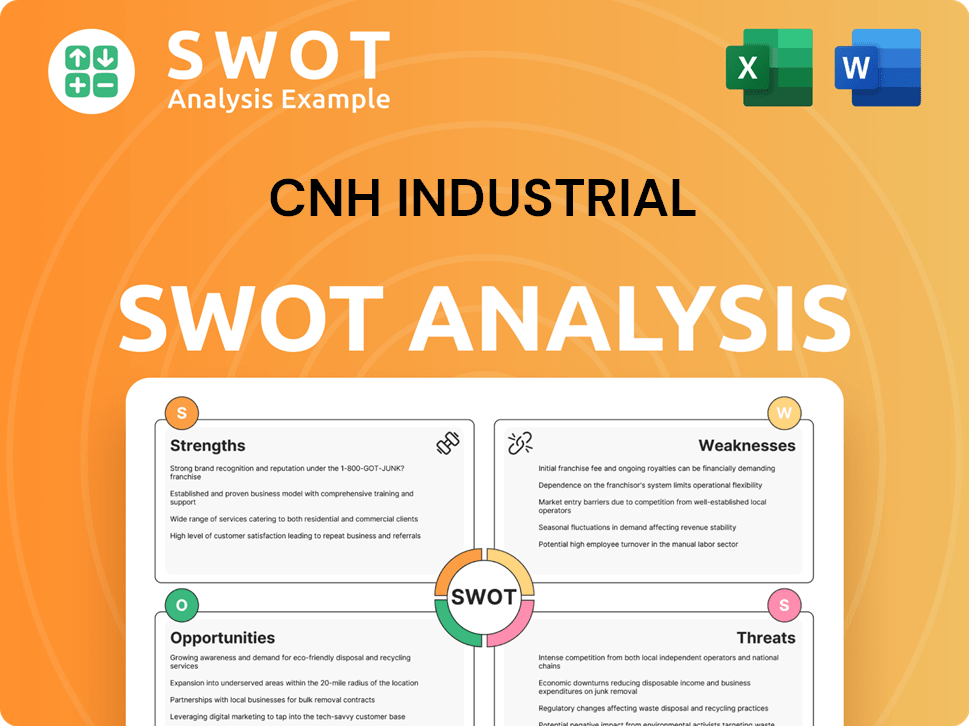
What Drove the Early Growth of CNH Industrial?
The early growth and expansion of the entities that would eventually form CNH Industrial were marked by innovation and strategic market penetration. Case Corporation, founded in 1842, quickly expanded beyond threshing machines to include steam engines, becoming a leading manufacturer. Similarly, New Holland, established in 1895, focused on practical agricultural solutions, gaining traction with early hay and forage equipment.
The 20th century saw significant expansion through product diversification and global reach for the CNH company. Both Case and New Holland introduced a wide array of tractors, harvesters, and construction equipment. This expansion was crucial for meeting the diverse needs of both agricultural and construction sectors. This diversification allowed the company to capture a broader market share and adapt to changing industry demands.
Key acquisitions and mergers were instrumental in the growth of CNH. The 1999 merger of New Holland N.V. and Case Corporation to form CNH Global N.V. was a significant consolidation, creating a more formidable competitor in the agricultural and construction equipment markets. These strategic moves helped to streamline operations and increase market presence. The merger allowed for better resource allocation and enhanced product offerings.
This period also saw the establishment of extensive dealer networks and manufacturing facilities across continents. This expansion allowed CNH to adapt to regional market demands, ensuring that products and services were accessible globally. By establishing a strong global presence, the company was able to better serve its international customer base. This expansion was a key factor in the company's long-term growth strategy.
The competitive landscape was intense, with numerous players vying for market share, which often spurred technological advancements and strategic pricing. Leadership transitions throughout these periods often brought new strategic directions, focusing on operational efficiencies, research and development, and expanding into emerging markets. The CNH company constantly adapted to maintain its competitive edge. This dynamic environment drove innovation and efficiency.
CNH Industrial PESTLE Analysis
- Covers All 6 PESTLE Categories
- No Research Needed – Save Hours of Work
- Built by Experts, Trusted by Consultants
- Instant Download, Ready to Use
- 100% Editable, Fully Customizable
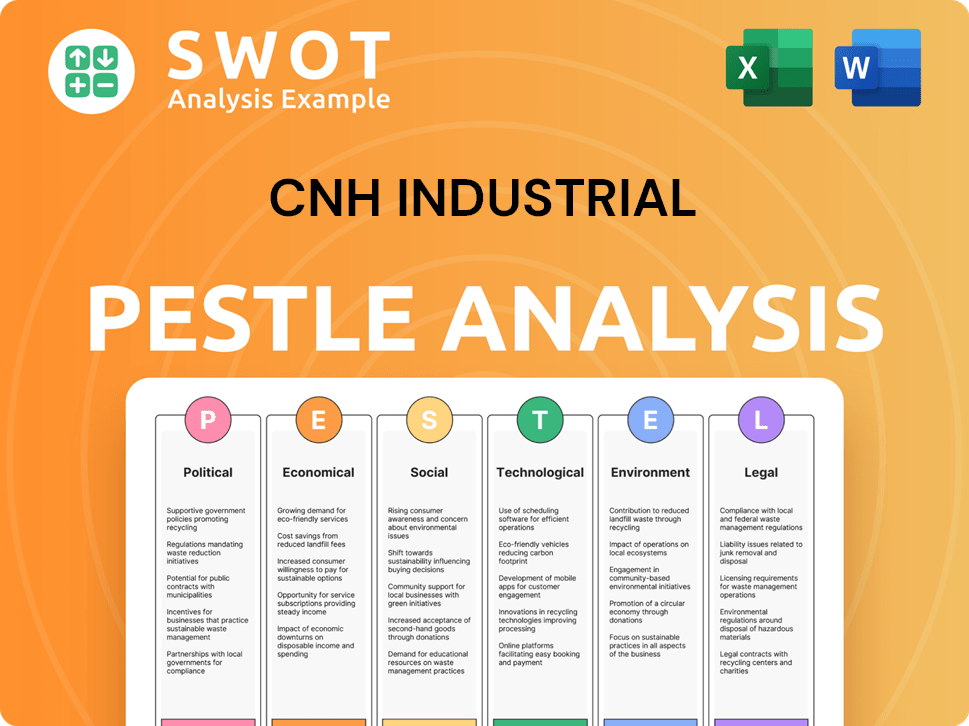
What are the key Milestones in CNH Industrial history?
The CNH Industrial company has a rich history marked by significant milestones in the agricultural and construction equipment industries. This journey has seen the evolution of brands like Case IH and New Holland, each contributing to the company's global presence and technological advancements. The CNH history is a testament to its adaptability and innovation.
| Year | Milestone |
|---|---|
| 1923 | Case IH introduced the first self-propelled combine harvester, revolutionizing grain harvesting. |
| Ongoing | New Holland consistently innovates in baling technology and clean energy solutions for agriculture. |
| 2024 | CNH Industrial continues to invest in automation and digital solutions to enhance productivity and sustainability. |
CNH Industrial has consistently pushed the boundaries of innovation. The company has secured patents for a wide array of technologies, from advanced hydraulics to precision farming systems and alternative fuel powertrains. Partnerships with technology firms for autonomous solutions have also been key achievements, showcasing its commitment to future-ready solutions.
Case IH's introduction of the first self-propelled combine harvester in 1923 was a groundbreaking innovation. This innovation significantly increased the efficiency of grain harvesting, setting a new standard for the industry.
New Holland's advancements in baling technology have been pivotal in modern agriculture. These innovations have improved the efficiency and effectiveness of hay and straw management.
New Holland's focus on clean energy solutions reflects a commitment to sustainability. This includes the development of tractors and other equipment that utilize alternative fuels, reducing environmental impact.
FPT Industrial consistently develops engines that meet stringent emission standards while delivering high performance. This focus ensures that CNH Industrial's products comply with global environmental regulations.
CNH Industrial has invested heavily in precision farming systems. These technologies help optimize resource use and increase yields, contributing to sustainable agricultural practices.
Collaborations with technology firms for autonomous solutions are a key part of CNH Industrial's innovation strategy. This includes developing self-driving tractors and other equipment to enhance efficiency.
Despite its successes, CNH Industrial has faced challenges. Economic downturns, like the 2008 financial crisis, impacted demand, necessitating production adjustments. Intense competition from other global manufacturers has also required continuous innovation and cost efficiencies. The company has also dealt with integrating diverse corporate cultures following mergers and acquisitions, as it is vital to understand the Marketing Strategy of CNH Industrial.
Economic downturns have historically impacted demand for capital goods, requiring CNH Industrial to adjust production and implement restructuring efforts. These adjustments are crucial for maintaining financial stability during economic fluctuations.
Intense competition from other global manufacturers necessitates continuous innovation and cost efficiencies. Staying ahead in a competitive market requires strategic investments in research and development.
Product failures or recalls, while rare, have presented obstacles, requiring prompt responses and quality control enhancements. Addressing these issues swiftly is essential for maintaining brand reputation and customer trust.
Integrating diverse corporate cultures following mergers and acquisitions, culminating in the formation of CNH Industrial, posed significant management and operational challenges. Successfully merging these cultures requires strategic planning and effective communication.
Strategic restructuring and rebranding efforts have been key to unifying the portfolio and improving operational efficiency. These changes have helped CNH Industrial adapt to market demands and enhance its global presence.
Investing in sustainable solutions and advanced technologies is crucial for meeting future industry demands. This includes developing products that reduce emissions and promote environmental sustainability.
CNH Industrial Business Model Canvas
- Complete 9-Block Business Model Canvas
- Effortlessly Communicate Your Business Strategy
- Investor-Ready BMC Format
- 100% Editable and Customizable
- Clear and Structured Layout
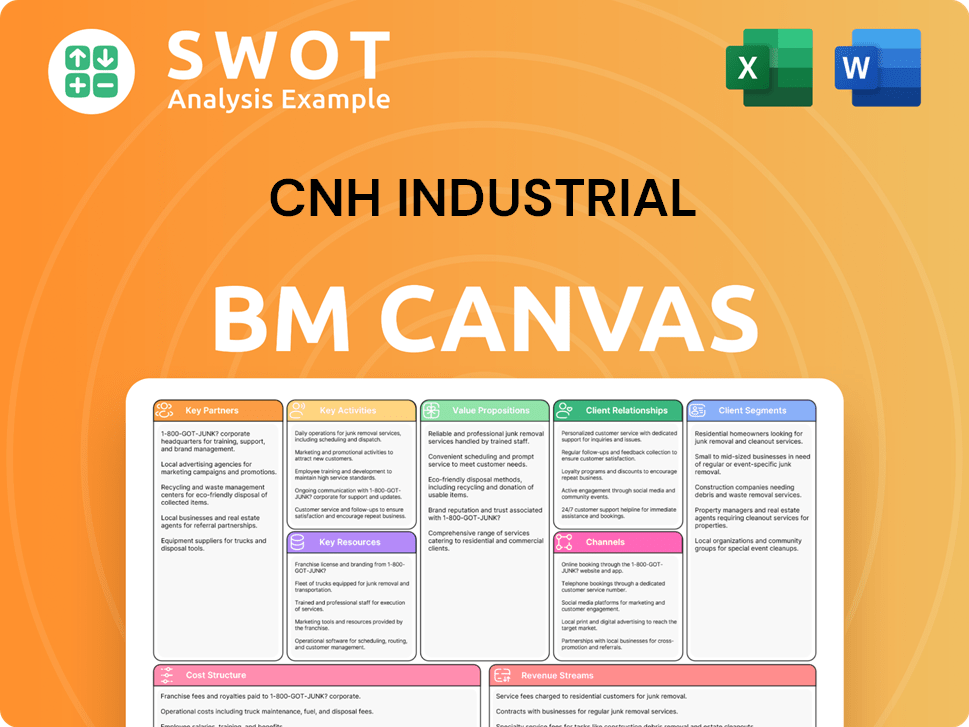
What is the Timeline of Key Events for CNH Industrial?
The CNH Industrial company has a rich history, evolving from several pioneering agricultural and industrial equipment manufacturers. This evolution includes key mergers, acquisitions, and strategic shifts that have shaped the company into a global leader. The company’s timeline demonstrates its ability to adapt and innovate within the agricultural and construction equipment sectors.
| Year | Key Event |
|---|---|
| 1842 | Jerome Increase Case founded Case Corporation, focusing on threshing machines. |
| 1895 | Abe Zimmerman established New Holland Machine Company. |
| 1919 | Fiat Trattori, a precursor to Fiat Industrial, began tractor production. |
| 1974 | Fiat acquired a stake in agricultural machinery manufacturer Laverda. |
| 1999 | New Holland N.V. and Case Corporation merged to form CNH Global N.V. |
| 2011 | Fiat Industrial S.p.A. was spun off from Fiat S.p.A., encompassing CNH Global, Iveco, and FPT Industrial. |
| 2012 | Fiat Industrial S.p.A. and CNH Global N.V. merged to form CNH Industrial N.V. |
| 2013 | CNH Industrial N.V. began trading on the NYSE and Mercato Telematico Azionario. |
| 2022 | CNH Industrial completed the spin-off of its On-Highway business (Iveco Group). |
| 2024 | CNH Industrial continues to focus on its Agriculture and Construction segments, emphasizing automation and digital solutions. |
CNH Industrial is strategically focused on sustainable agricultural and construction solutions. This includes leveraging automation, electrification, and digital services to enhance product offerings. The company aims to expand its precision agriculture offerings and develop electric and alternative fuel construction equipment.
Market expansion plans target emerging economies and further penetration in established markets. CNH Industrial plans to tailor product offerings to meet diverse regional needs. The company's growth strategy includes increasing its market share in key regions and expanding its global footprint.
Industry trends such as increasing demand for sustainable practices, precision technology, and autonomous operations are expected to significantly impact CNH Industrial's future. The company is well-positioned to capitalize on these trends due to its focus on innovation and advanced technologies. These trends are driving the evolution of both agricultural equipment and construction equipment.
Analyst predictions for 2024-2025 often highlight the company's strong position in the agricultural sector. The company's potential for growth in construction is driven by infrastructure investments. CNH Industrial's commitment to innovation and sustainability supports positive financial outlooks.
CNH Industrial Porter's Five Forces Analysis
- Covers All 5 Competitive Forces in Detail
- Structured for Consultants, Students, and Founders
- 100% Editable in Microsoft Word & Excel
- Instant Digital Download – Use Immediately
- Compatible with Mac & PC – Fully Unlocked
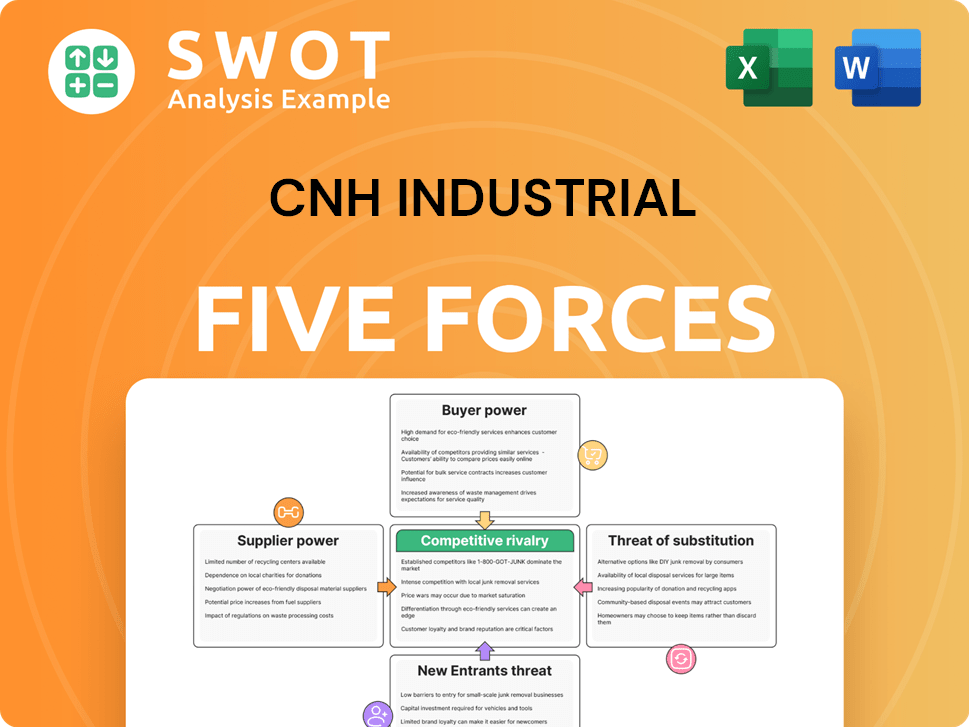
Related Blogs
- What is Competitive Landscape of CNH Industrial Company?
- What is Growth Strategy and Future Prospects of CNH Industrial Company?
- How Does CNH Industrial Company Work?
- What is Sales and Marketing Strategy of CNH Industrial Company?
- What is Brief History of CNH Industrial Company?
- Who Owns CNH Industrial Company?
- What is Customer Demographics and Target Market of CNH Industrial Company?
Disclaimer
All information, articles, and product details provided on this website are for general informational and educational purposes only. We do not claim any ownership over, nor do we intend to infringe upon, any trademarks, copyrights, logos, brand names, or other intellectual property mentioned or depicted on this site. Such intellectual property remains the property of its respective owners, and any references here are made solely for identification or informational purposes, without implying any affiliation, endorsement, or partnership.
We make no representations or warranties, express or implied, regarding the accuracy, completeness, or suitability of any content or products presented. Nothing on this website should be construed as legal, tax, investment, financial, medical, or other professional advice. In addition, no part of this site—including articles or product references—constitutes a solicitation, recommendation, endorsement, advertisement, or offer to buy or sell any securities, franchises, or other financial instruments, particularly in jurisdictions where such activity would be unlawful.
All content is of a general nature and may not address the specific circumstances of any individual or entity. It is not a substitute for professional advice or services. Any actions you take based on the information provided here are strictly at your own risk. You accept full responsibility for any decisions or outcomes arising from your use of this website and agree to release us from any liability in connection with your use of, or reliance upon, the content or products found herein.